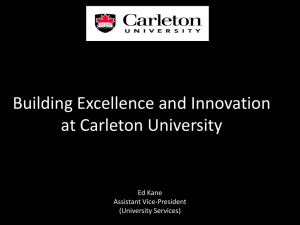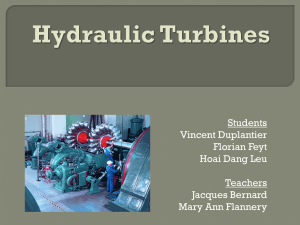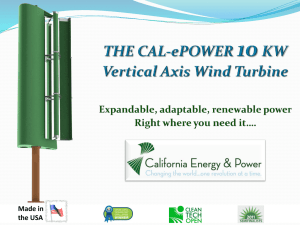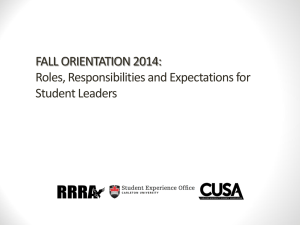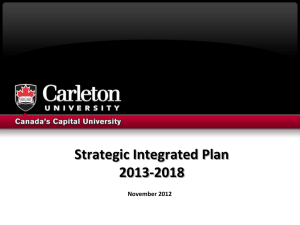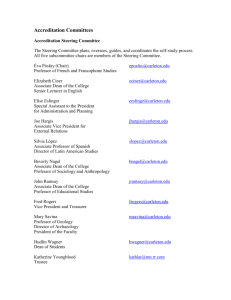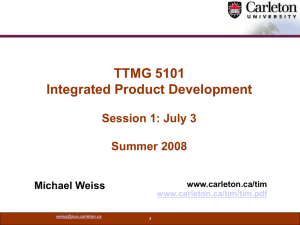Alternative Power Small Wind - West Carleton Environmental Centre
advertisement
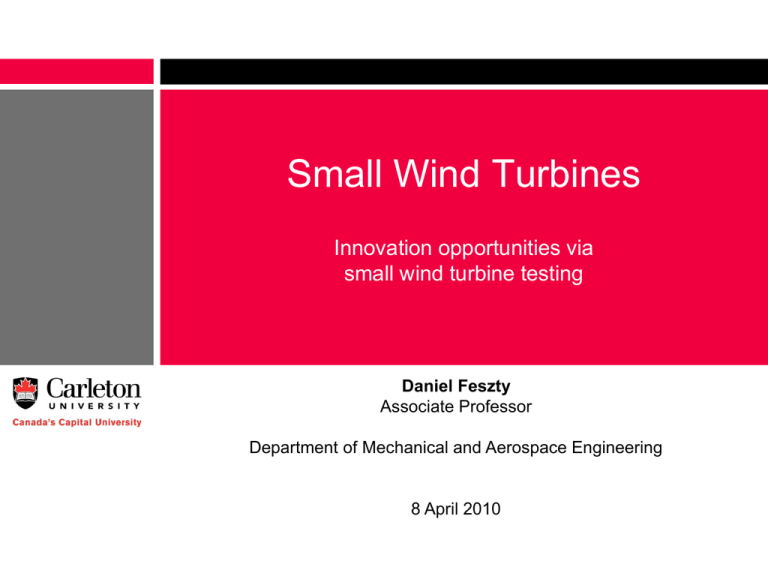
Small Wind Turbines Innovation opportunities via small wind turbine testing Daniel Feszty Associate Professor Department of Mechanical and Aerospace Engineering 8 April 2010 Outline Wind energy research at Carleton University Wind energy overview Areas requiring research Potential research at WCEC 2 Wind energy research at Carleton University 3 Wind energy research at Carleton University Primarily conducted by – Rotorcraft Research Group – 4 Professors, 18 researchers – Transferring knowledge from helicopters to wind turbines 4 Wind energy research at Carleton University Prof. Fred Nitzsche – PhD - Stanford University (1983) – Thesis on Darrieus wind turbines 5 Wind energy research at Carleton University Strong in experiments: Scaled wind farm experiment at Carleton University 6 Wind energy research at Carleton University Strong in computations: CFD (Computational Fluid Dynamics) simulations for a helicopter and a wind turbine 7 Wind energy research at Carleton University Our PhD graduates found employment at: - Vestas (Denmark): 2 - National Research Council, Ottawa (Wind Energy group): 3 8 Wind energy overview 9 Wind energy overview: Wind energy usage Wind energy usage in Canada: 30% growth annually!!! 10 Wind energy overview: Wind resources Mean annual wind speed distribution in Canada (Canadian Wind Atlas) 11 Wind energy overview: Wind resources Mean annual wind speed distribution in Ontario (Canadian Wind Atlas) 12 Wind energy overview: Classification of wind power Ontario inland Most of Canada Most turbines built for 13 Wind energy overview: Wind resources Category 6 & 7 sites not available Mostly sold out Far from big cities Category 3-5 sites Not utilized so far (most of Ontario/Canada) Lack of efficient wind turbines for them 14 Wind energy overview: Wind turbine types Two basic types of wind turbines: Vertical Axis ADV: DIS: works in any wind direction medium power Horizontal Axis very high power needs to be “yawed”(turned) into wind direction 15 Wind energy overview: Wind turbine types Two basic types of wind turbines: Vertical Axis (no yaw control, medium power, smaller): Savonius-rotor Darrieus-rotor H-rotor 16 Wind energy overview: Wind turbine types Two basic types of wind turbines: Horizontal Axis (yaw control, high power, larger): 17 Wind energy overview: Size vs. power Power from wind grows with D2: • P = 0.5 r v3 A = 0.5 r v3 (p D2)/4 need large turbine! 160 m 1 MW = 300 homes Diameter [m] 126 m 112 m 80 m A380 15 m ‘85 ‘87 ‘89 ‘91 ‘93 ‘95 ‘97 ‘99 ‘01 ‘03 ‘06 0.06 0.3 0.5 1.3 1.6 2.0 4.5 5.0 ? 8.0 Year Power [MW] 18 Wind energy overview: Interference effects Wake interference: 30-40% loss of power when in wake! 19 Wind energy overview: Interference effects W 3D Wind Direction 20 Wind energy overview: Interference effects Power of the downstream turbine is reduced by 40% Wind Direction 21 Wind energy overview: Interference effects Scaled wind farm experiment at Carleton University 22 Wind energy overview: Modern Horizontal Axis Turbines designed for category 6-7 wind "clean" flow growing size (D = 120-160 m) is a problem for transportation installation maintenance availability COST! 23 The Aeloun Harvester: Cheap, small turbine for the 3rd world 24 Areas requiring research 25 Areas requiring research: Smaller turbines for lower category (3-5) wind speeds Would be very interesting for Ontario/Canada Cheap, small turbines for 3rd world countries (“Lighting up Africa”) What size and type? Interference effects mitigation: Special blade design for “dirty” flow? Actively controlled blades? Better wake modelling/prediction Current wake models overpredict power by about 15% This means $90 million loss for a 120 turbine farm 26 Areas requiring research: To answer the above questions, one needs: Advanced computational methods (for design and optimization) Full-size experiments to validate these For experiments: Wind tunnels simply not suited (test section too small & short) Need: “wind testing” instead of “wind tunnel testing” Carleton University does not have a suitable site for “wind testing” 27 Potential research at West Carleton Energy Centre (WCEC) 28 Potential research at WCEC Need for experimental testing Carleton University needs large wind exposed site to test research turbines WCEC could be ideal to serve as Carleton’s “wind test site” testing small (or scaled) turbines not fitting a wind tunnel foundation not an issue turbines on top or at bottom of hill data used to validate CFD (Computational Fluid Dynamics) CFD used to design better wind turbines 29 Potential research at WCEC OR: combine solar and wind research? Thermal upwind power plant Experimental thermal upwind power plant in Manzanares, Spain, 1985. Tower height 200 m, tower diameter 10 m, diameter of collector roof about 250 m 30 Questions? 31 Questions? 32

